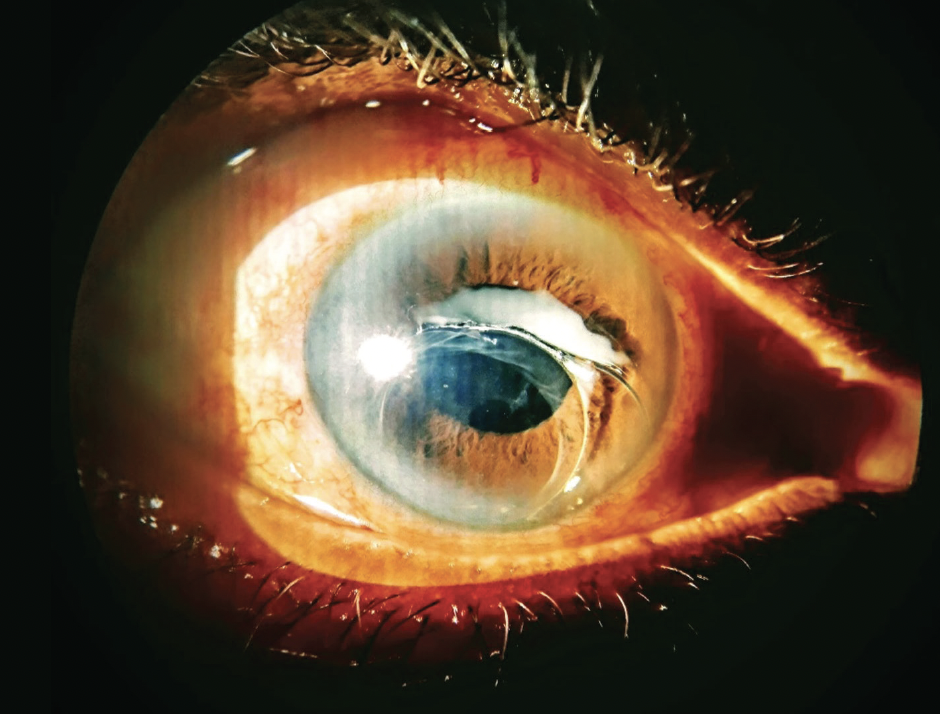A 72-year-old man presented 4 to 5 days after experiencing a sudden decrease in the vision in his right eye. There was no history of trauma or preceding illness. The patient had been receiving medical treatment for hypertension for 20 years. His ocular history was significant for retinitis pigmentosa (RP) in both eyes. He had undergone cataract surgery with IOL implantation in both eyes 10 years ago. Follow-up visits for 2 to 3 years postoperatively indicated reasonably good vision in both eyes.
EXAMINATION
On examination, the patient’s visual acuity was hand motion OD and 20/200 OS. His IOP was 16 mm Hg OD and 14 mm Hg OS on applanation tonometry. A slit-lamp examination of the right eye showed an anteriorly dislocated IOL–capsular bag complex in the anterior chamber (Figure). In the left eye, the IOL was centered in the bag. A dilated examination found RP, optic discs with a waxy pallor, and diffuse mottling of the macular regions. Both pupils reacted sluggishly to light. B-scan ultrasonography of the right eye revealed an intact retina-choroid-sclera complex.

Figure. Slit-lamp image showing a dislocated IOL–capsular bag complex in the anterior chamber of the right eye. Note the cortical remnant superior to the IOL.
SURGICAL INTERVENTION
Surgical removal of the IOL–capsular bag complex and an IOL exchange were planned for the right eye. A corneoscleral incision was performed superiorly, and the IOL–capsular bag complex was removed. No vitreous disturbance was noted. Retropupillary placement of an iris claw lens was performed. A superior surgical peripheral iridectomy was performed to prevent secondary glaucoma. Routine topical antibiotics and steroids were prescribed for the postoperative period.
POSTOPERATIVE OUTCOME
On postoperative day 1, the patient’s visual acuity was counting fingers at 3 m, and the iris claw IOL was well centered. Six weeks later, his BCVA was 20/200 OD with a manifest refraction of +1.00 -2.00 x 90º. The cornea was clear, and the anterior chamber was quiet.
KEY LEARNING POINTS
No. 1: Zonular Weakness in Retinitis Pigmentosa
- Significance: Common in cataract patients
- Preoperative tip: Look for phacodonesis.
No. 2: Surgical Considerations
- Discuss risks: Inform patients with retinitis pigmentosa about the risk of late dislocation and potential need for additional surgery.
- Anticipate weakness: Be prepared during surgery.
No.3: Surgical Modifications
- Technical adjustments:
- Gentle tissue handling
- Larger capsulorhexis
- Thorough hydrodissection
- Bimanual nucleus rotation
- Use of capsular tension rings
- Low-energy phacoemulsification
- Chop technique preferred
- Phacoemulsification in epinucleus mode
- Three-piece lens for stability
No. 4: Postoperative Care
- Follow-up visits: Monitor patient for phimosis, IOL dislocation, and macular edema.
- Protection: Advise use of protective glasses.
- Nd:YAG laser intervention: Use minimal energy.
- Immediate intervention: Act quickly to manage complications.
No. 5: Handling Complete Posterior Dislocation
- Pars plana approach: Required for complete posterior dislocation.
- Procedure choice: Based on surgeon’s preferences, patient condition, affordability.
- Scleral fixation: Demanding but better results.
- Tailored treatment: Customize approach based on case factors.
DISCUSSION
Late Dislocation: Definition and Risk Factors
Late dislocation of an IOL occurs 3 months or more after surgery.1 Predisposing conditions include pseudoexfoliation, previous vitreoretinal surgery, myopia/increased axial length, RP, trauma, connective tissue disorders, and eye rubbing.2,3 Factors causing late dislocations in patients with RP include capsular phimosis and zonular weakness.4,5
This patient had spontaneous dislocation and underlying RP. Zonular weakness appeared to be the pathogenetic mechanism because significant capsular phimosis was not noted.
Surgical Approach
An IOL exchange with retropupillary placement of an iris claw lens was performed in a single step. A two-stage process, where the IOL–capsular bag complex is removed first and IOL fixation is performed second, may also be considered. Given the patient’s age and his unwillingness to undergo multiple time-consuming procedures, a single-step procedure with an iris claw IOL was chosen.
Postoperative Observation
Close observation for corneal decompensation and cystoid macular edema is vital. In this case, there were no signs of corneal decompensation, and no cystoid macular edema was observed during 3 months of follow-up. The other eye had a stable IOL in the bag without capsular phimosis. If phimosis had been present, a laser capsulotomy of the anterior capsule using low energy would have been appropriate.
IOL FIXATION TECHNIQUES
In the past few decades, various procedures have been developed for the fixation of an IOL in an aphakic eye without capsular support. These include angle-supported IOLs and iris- and scleral-fixated IOLs.6
Angle-Supported IOLs
Angle-supported IOLs are associated with corneal decompensation and secondary glaucoma.7
Iris Fixation
Iris fixation involves suturing the IOL to the iris. The technique is useful for dislocated IOLs previously located in the bag or sulcus, eyes that have a filtering bleb, and situations in which it is important to preserve conjunctival tissue for future procedures.8 An iris claw IOL has two claws that facilitate enclavation onto the iris. This inexpensive technique has a short learning curve. It takes less time than and has complication rates similar to those of scleral fixation.9 The placement of an iris claw lens, however, may result in increased astigmatism and pupil ovalization.10
Scleral Fixation
Scleral fixation results in better outcomes and less inflammation compared to iris fixation. The technique is useful in eyes with low endothelial counts,11 but it is time-consuming and requires considerable training.
There has been a shift from sutured to sutureless scleral fixation procedures.12 The glued IOL technique described by Agarwal et al13 provides good flap closure and IOL centration and stability without suture-related complications. Yamane et al14 described a sutureless scleral fixation technique and later fine-tuned it by cauterizing the haptics after externalization, creating flanges. A new foldable scleral IOL developed by Carlevale et al15 has scleral harpoons that enable sutureless anchorage to the sclera. Using the Canabrava technique, an IOL can be fixated to the sclera with segments of polypropylene (Prolene, Ethicon) with two flanges created in the eyelets of the IOL and two in the sutures, which are inserted into the scleral tunnel to fixate the IOL.16
1. Ascaso FJ, Huerva V, Grzybowski A. Epidemiology, etiology, and prevention of late IOL-capsular bag complex dislocation: review of the literature. J Ophthalmol. 2015;2015:805706.
2. Kristianslund O, Råen M, Østern AE, Drolsum L. Late in-the-bag intraocular lens dislocation: a randomized clinical trial comparing lens repositioning and lens exchange. Ophthalmology. 2017;124(2):151-159.
3. Poh EP, Fariza NN, Mariam I. Bilateral anterior chamber intraocular lenses dislocation in a patient with habitual eye rubbing. Med J Malaysia. 2005;60(3):370-372.
4. Hayashi K, Hayashi H, Matsuo K, Nakao F, Hayashi F. Anterior capsule contraction and intraocular lens dislocation after implant surgery in eyes with retinitis pigmentosa. Ophthalmology. 1998;105(7):1239-1243.
5. Lee HJ, Min SH, Kim TY. Bilateral spontaneous dislocation of intraocular lenses within the capsular bag in a retinitis pigmentosa patient. Korean J Ophthalmol. 2004;18(1):52-57.
6. Forlini M, Bedi R. Intraocular lens implantation in the absence of capsular support: scleral-fixated vs retropupillary iris-claw intraocular lenses. J Cataract Refract Surg. 2021;47(6):792-801.
7. Patel SR, Chu DS, Ayres BD, Hersh PS. Corneal edema and penetrating keratoplasty after anterior chamber phakic intraocular lens implantation. J Cataract Refract Surg. 2005;31(11):2212-2215.
8. Karmel, M. Iris suture fixation: new take on an old technique. American Academy of Ophthalmology. 2016. Accessed July 31, 2021. https://www.aao.org/eyenet/article/iris-suture-fixation-new-take-on-old-technique
9. Boccuzzi D, Purva D, Orfeo V, et al. Supporting IOL’S in a deficient capsular environment: the tale of no “tails”. J Ophthalmol. 2021;2021:9933486.
10. Madhivanan N, Sengupta S, Sindal M, Nivean PD, Kumar MA, Ariga M. Comparative analysis of retropupillary iris claw versus scleral-fixated intraocular lens in the management of post-cataract aphakia. Indian J Ophthalmol. 2019;67(1):59-63.
11. Chang YM, Weng TH, Tai MC, et al. A meta-analysis of sutureless scleral-fixated intraocular lens versus retropupillary iris claw intraocular lens for the management of aphakia. Sci Rep. 2024;14(1):2044.
12. Gurney NT, Al-Mohtaseb Z. Intraocular lens implantation in the absence of capsular support. Saudi J Ophthalmol. 2022;36(2):157-162.
13. Agarwal A, Kumar DA, Jacob S, Baid C, Agarwal A, Srinivasan S. Fibrin glue-assisted sutureless posterior chamber intraocular lens implantation in eyes with deficient posterior capsules. J Cataract Refract Surg. 2008;34(9):1433-1438.
14. Suren E, Kalayci M, Cetinkaya E, et al. Evaluation of the findings of patients who underwent sutureless flanged transconjunctival intrascleral intraocular lens implantation with or without pars plana vitrectomy. J Ophthalmol. 2021:4617583.
15. Abed E, Forlini M, Bendo E, et al. One year outcomes and stability of a novel scleral anchored intraocular lens. J Ophthalmol. 2021;2021:3838456.
16. Canabrava S, Canedo Domingos Lima AC, Ribeiro G. Four-flanged intrascleral intraocular lens fixation technique: no flaps, no knots, no glue. Cornea. 2020;39(4):527-528.




